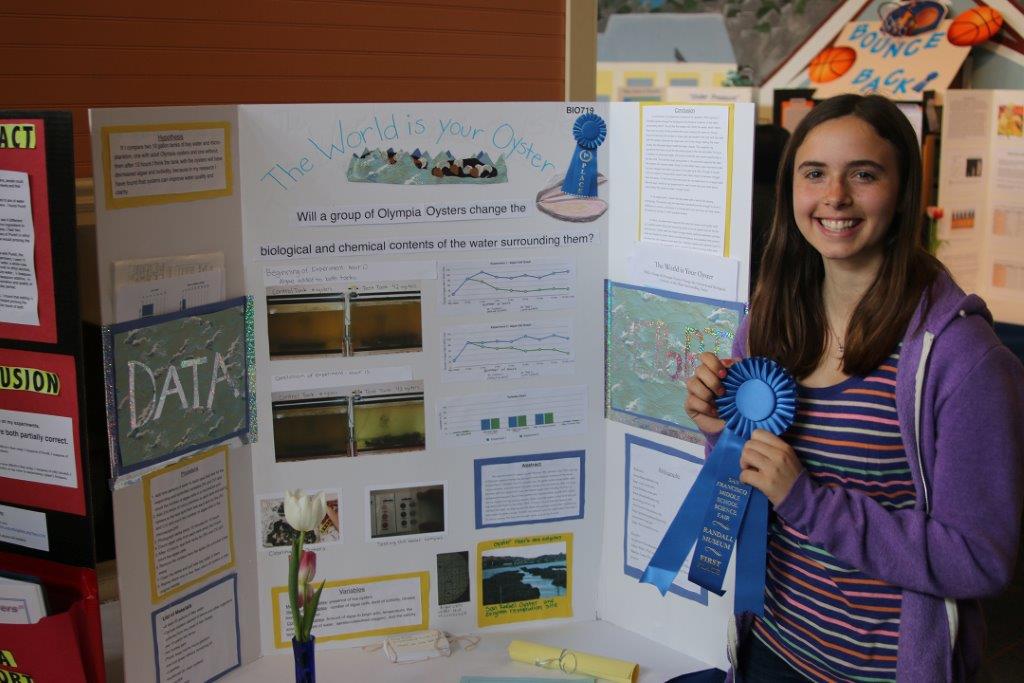
Chloe Jenniches, a student at A.P. Giannini Middle School, won first place in the San Francisco Citywide Science Fair’s seventh grade biological science category with her project “The World is Your Oyster.”
Credit: California State Coastal Conservancy
Lack of science literacy in the United States is at an all-time high, while student science achievement is at an all-time low. Only about 31% of eighth graders scored at or above the proficient level in science in the 2024 “Nation’s Report Card,” or NAEP test.
Results are similar in California. The California Science Test (CAST), administered to students in fifth, eighth and high school, shows that only about one-third scored proficient or advanced in 2025. A tremendous achievement gap persists — just 15% of Black students scored proficient or advanced on this year’s science tests.
It’s time for California to begin addressing the massive embarrassment of science illiteracy. One obvious way to spark student interest in science is to reignite the science fair.
While science fairs alone won’t overcome deficits in science understanding, they can pique students’ interest by letting them apply scientific reasoning to solve real-world problems that matter to them. In addition, there is the benefit of making science more visible and celebrated within the community.
The science fair has a long and distinguished history in the U.S. It began in the 1940s with the Science Talent Search to encourage research and scientific careers. Fairs grew rapidly after the 1957 launch of Sputnik, as the U.S. sought to strengthen science education during the Cold War. Over time, fairs evolved to include engineering, computer science, and environmental projects. Today, national competitions like the Regeneron ISEF and the Science Talent Search continue the legacy.
Currently, science fairs are held at the school, district, state and national levels. In California, local winners advance to the statewide California Science & Engineering Fair (CSEF), and top projects there may qualify for the Regeneron International Science & Engineering Fair. The California Science Fair hosts 800 to 1,000 students annually (the 2025 event featured 881 participants from 351 schools).
But too few California students can participate in science fairs. Most are voluntary, though eventually making them mandatory would improve participation. Participation is uneven — skewing toward suburban schools and underrepresenting rural and low-income areas. Access depends heavily on local resources, teacher time, mentorship, lab space and travel funding.
Many notable Americans got their start in science fairs. Bill Gates once won for a program that played tic-tac-toe — an early sign of his software talent. U.S. Rep. Alexandria Ocasio-Cortez won second place at the Intel International Science and Engineering Fair for microbiology research. A small asteroid now bears her name in recognition.
Science fairs can also benefit entire communities. When students investigate local issues — like water quality, pollution or energy use — their projects can yield real solutions. During the Flint water crisis in Michigan, science fair projects helped raise awareness about lead contamination. Students tested local samples, presented findings at fairs, and shared results with public health groups.
Another key benefit is mentorship. Scientists and STEM professionals can guide students through project development, support teachers, and connect students to equipment and labs.
As a former science teacher who organized fairs at multiple levels, I have no illusions. Science fairs aren’t perfect. Some students still build baking soda volcanoes or test whether Taylor Swift songs help plants grow. Some parents take over their child’s project. But when well-structured and mentored, science fairs can deeply engage students and reinforce real science content and methods.
There is no substitute for rigorous science instruction. Students won’t discover Newton’s Laws on their own — but they can apply them within their science fair projects.
To make the science fair successful, schools, districts, and state must collaborate through the following actions:
- Make science fair participation mandatory.
- Fund transportation, stipends, and travel scholarships.
- Invest in teacher support and release time.
- Build school–university/industry mentor pipelines.
- Lower administrative barriers for teachers and younger students.
- Expand hybrid/virtual options with an equity focus.
- Standardize and publish participation metrics.
- Prioritize outreach to underrepresented communities.
- Fund regional “research incubators” for multiyear projects.
- Strengthen judge training and quality.
- Link fairs to college/career pathways and internships.
California could expand the reach and impact of science fairs with a phased implementation process:
- Pilot (Year 1): Select four underrepresented counties (one rural, one Central Valley, two urban). Fund travel stipends, a university mentor-matching program, and a judge training pilot. The funding for this phase would come through a combination of district, state, and private organizations.
- Scale (Years 2–3): Expand successful elements statewide based on evaluation results. Create an annual participation dashboard.
- Sustain (Year 4+): Institutionalize line items in county education budgets and secure multi-year corporate/university sponsorships.
Costs for the pilot phase could run between $2,000 and $5,000 per school. Costs for the scale and sustainability phases could run up to $15,000 per school.
So, let us reignite and expand the science fair in California.
When a student experiments, a community learns.
•••
Bill Conrad has been an educator for over 45 years and has worked extensively within school districts throughout the country in a wide variety of capacities including as an honors middle school science teacher and administrator.
The opinions expressed in this commentary represent those of the author. EdSource welcomes commentaries representing diverse points of view. If you would like to submit a commentary, please review our guidelines and contact us.

